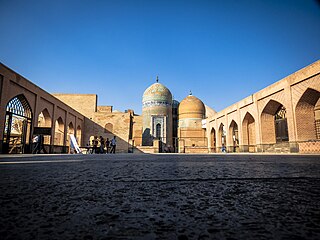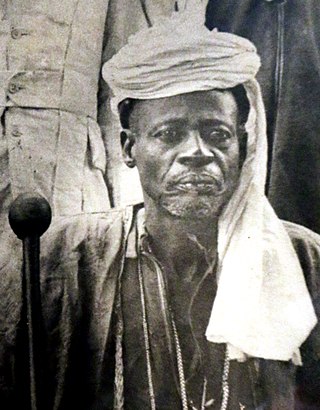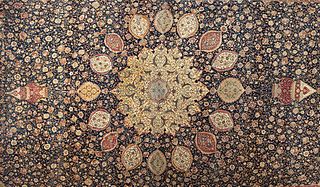
A mausoleum is an external free-standing building constructed as a monument enclosing the burial chamber of a deceased person or people. A mausoleum without the person's remains is called a cenotaph. A mausoleum may be considered a type of tomb, or the tomb may be considered to be within the mausoleum.

The traditional culture of Korea is the shared cultural and historical heritage of Korea before the division of Korea in 1945.

The Luhya are a Bantu people and the second largest ethnic group in Kenya. The Luhya belong to the larger linguistic stock known as the Bantu. The Luhya are located in western Kenya and Uganda. They are divided into 20 culturally and linguistically united clans. Once known as the Kavirondo, multiple small tribes in North Nyanza came together under the new name Baluhya between 1950 and 1960. The Bukusu are the largest Luhya subtribe and account for almost 30% of the entire Luhya population.

Al-Rifa'i Mosque is located in Citadel Square, adjacent to the Cairo Citadel. Its name is derived from the Ali Abu Shubbak who is buried in the mosque. Now, it is also the royal mausoleum of Muhammad Ali's family. The building is located opposite the Mosque-Madrassa of Sultan Hassan, which dates from around 1361, and was architecturally conceived as a complement to the older structure as part of a vast campaign by the 19th century rulers of Egypt to both associate themselves with the perceived glory of earlier periods in Egypt's Islamic history and modernize the city.
Mwami is an honorific title common in parts of Central and East Africa. The title means chief or tribal chief in several Bantu languages. It was historically used by kings in several African nations, and is still used for traditional kings or rulers of regions within several African nation-states.
Matungu is a small town in the Western Province of Kenya. It is located in the Kakamega County.
Mumias is a town in Kakamega County of Kenya. The town has an urban population of 116,358 and is the second largest town in Kakamega County. Mumias was the centre of the Mumias District. The town is linked by road to Kakamega, Busia (west), Bungoma (north), Butere, Luanda, Maseno and Kisumu (south). Two major rivers, River Nzoia and River Lusumu pass close to the town.
Butere is a town in Kakamega County, which was formerly part of the Western Province of Kenya. According to the 2009 Kenya National Census, it has an urban population of 4,725. Until 2010, Butere served as the capital of the former Butere/Mumias District.

The Maragoli, or Logoli (Ava-Logooli), are now the second-largest ethnic group of the 6 million-strong Luhya nation in Kenya, numbering around 2.1 million, or 15% of the Luhya people according to the last Kenyan census. Their language is called Logoli, Lulogooli, Ululogooli, or Maragoli. The name Maragoli probably emerged later on after interaction of the people with missionaries of the Quaker Church.

The Kasubi Tombs in Kampala, Uganda, is the site of the burial grounds for four kabakas and other members of the Baganda royal family. As a result, the site remains an important spiritual and political site for the Ganda people, as well as an important example of traditional architecture. It became a UNESCO World Heritage Site in December 2001, when it was described as "one of the most remarkable buildings using purely vegetal materials in the entire region of sub-Saharan Africa".
Matayos is a settlement in the Busia County of Kenya's former Western Province. Matayos is a small township of about two thousand inhabitants along the B1 road, sixteen kilometres from the Busia border point, and about two kilometres east of the Sio River bridge. Matayos Division, whose seat is at Matayos centre is a very small borough covering the stretch of about twenty-two kilometres from Korinda junction near Busia town at its extreme west-point to the Rakite stream depression near Bumala junction to the east. The division is home to about eighty-thousand people.
The Kabras, or Kabarasi, are a subtribe of the Luhya people of Kenya. They reside in Malava that is in the Kabras Division of Kakamega District, which is neighboured by the Isukha, Banyala, Tsotso, and the Tachoni. The exact origin of the Luhya people is currently disputed, but there are historians who believe that the group came from Bethlehem and migrated to their present-day location by way of the so-called Great Bantu Migration.

Sheikh Safi al-Din Khānegāh and Shrine Ensemble is the tomb of Sheikh Safi-ad-din Ardabili located in Ardabil, Iran. In 2010, it was registered on the UNESCO World Heritage List.

Nabongo Mumia Shiundu was a prince who became 17th King of the Wanga Kingdom, a pre-colonial kingdom in Kenya and Uganda prominent for being a centralised, highly organised kingdom and the most advanced form of government in terms of politics, economy and military in pre-colonial Kenya. He later became paramount chief of an expansive region of Kenya and Uganda at the beginning of British imposition of colonial rule in East Africa.

The Wanga kingdom is a Bantu kingdom within Kenya, consisting of the Wanga (Abawanga) tribe of the Luhya people (Abaluyia). At its peak the kingdom covered an expansive area from Jinja in west to Naivasha in the East African Rift. The Wanga kingdom was a significant African empire and the most organized structure of government in pre-colonial Kenya politically, economically, and militarily.

In Islamic art, a shamsa is an intricately decorated rosette or medallion which is used in many contexts, including manuscripts, carpets, ornamental metalwork and architectural decoration such as the underside of domes. It can take a number of overall shapes, from circles to stars. The name means "little sun", as a diminutive of shams, the Arabic word meaning "sun", and the work is often stylised as a sunburst. It is characterized by the recurrent motifs present in Islamic art, such as the use of geometrical floral or vegetal forms in a repetitive design known as an arabesque. The arabesque is often used to symbolize the transcendent, indivisible and infinite nature of God, and as with other patterns and forms of Islamic art, the shamsa also has a religious significance, such as symbolizing the unity of God.
Nabongo Wanga was the founding father of the today's Wanga subtribe of the Luhya tribe of Kenya. He was born around 1050 A.D. His reign was between 1100 A.D. to his death around 1140 A.D.
Wabala was a Nabongo (King) who ruled the Abawanga around 1140 - 1190. His father was called Nabongo Wanga, the founding father of the famous Wanga Kingdom. It is said that Nabongo Wanga had several sons among them: Murono, Muniafu, Wabala, Namagwa and Mutende and that when his death came, there arose a succession dispute between his sons. Wanga had appointed Wabala as his successor over his elder brother, Murono. In the course of all the dispute, Wabala was assassinated in Bukhayo, and it was alleged that Murono was the one who instigated his brother's murder. Murono therefore arose to power at Matungu and enjoyed a short period of rein as the Nabongo. Later on, Wabala's son called Musui embattled Murono and Musui emerged to be the winner.
Nabongo Musui was one of the sons of Nabongo Wabala. Musuwi was possibly born in the 12th century in Matungu where the Wanga Kingdom's capital (Itookho) was located. There is no much information about his childhood. What is well known about Nabongo Musui is that when his grandfather, Wanga was about to die, he appointed Musui's father, Wabala as his successor over his elder brother, Murono. This caused a dispute among Wabala and Murono. Later, Wabala was assassinated in Bukhayo, so it was alleged that Murono was the one who had instigated his brother's murder. Murono therefore took power at Matungu and lasted a short period of rein as the Nabongo. Later on, Musui, Wabala's son engaged with his uncle, Murono in a battle and Musui emerged a winner. This made Murono to feel defeated and rejected. So, he decided to cross River Nzoia and established another kingdom at Indangalasia.












